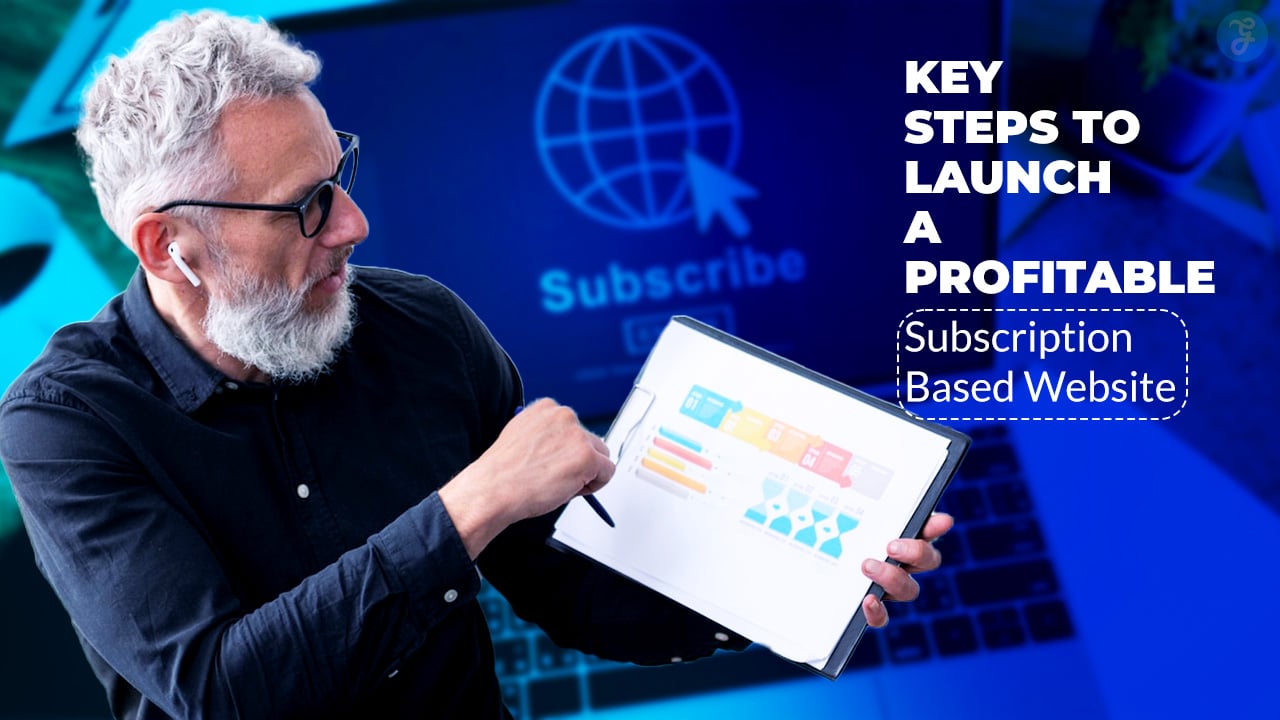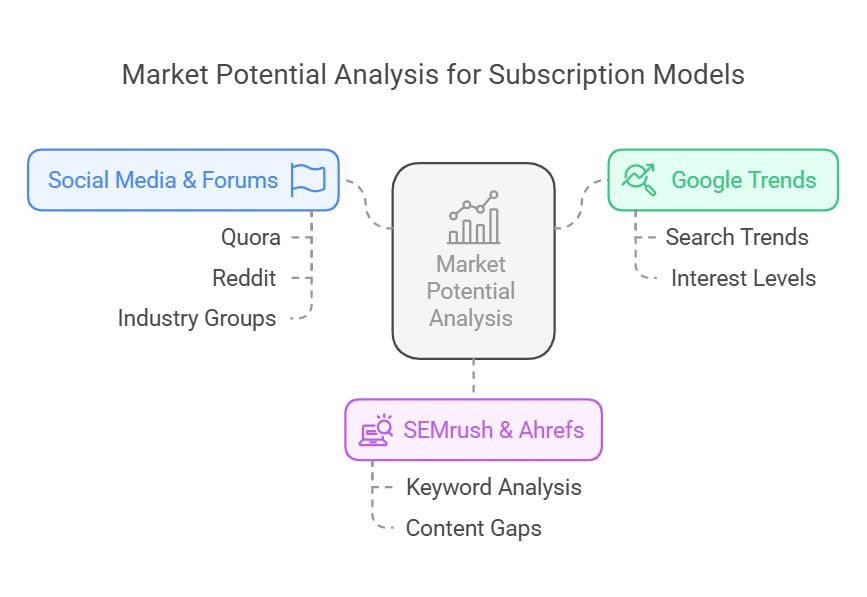The subscription business model has transformed how companies generate revenue and engage with customers.
From entertainment services like Netflix to SaaS platforms like Adobe Creative Cloud, subscription-based websites are dominating industries by providing consistent value and fostering customer loyalty.
If you’re looking to capitalize on this profitable model, understanding the key steps to launch a profitable subscription-based website is essential.
In this comprehensive guide, we’ll walk you through 10 crucial steps to build, launch, and scale a successful subscription website.
Whether you’re offering digital content, software, or exclusive services, this roadmap will ensure your venture thrives.
What is a Subscription-Based Website?
A subscription-based website provides users access to exclusive content, services, or products in exchange for a recurring fee.
This model ensures predictable revenue and fosters long-term customer relationships. Popular examples include:
- Streaming services – Netflix, Spotify, Disney+
- SaaS (Software as a Service) – Microsoft 365, Adobe Creative Cloud
- E-learning platforms – Coursera, MasterClass
- Membership communities – Patreon, OnlyFans
Why Choose a Subscription Model?
The subscription model offers several advantages:
- Steady Revenue Stream – Predictable income improves financial stability.
- Higher Customer Retention – Subscribers engage longer compared to one-time buyers.
- Scalability – Easily add new content or features to increase value.
- Customer Loyalty – Exclusive offerings enhance brand trust and long-term commitment.
Step 1 – Choose the Right Subscription Model
Choosing the right subscription model is critical to ensuring profitability and long-term customer retention.
The model you select should align with your business goals and audience preferences.
Types of Subscription Models
To launch a profitable subscription-based website, start by identifying a niche with high demand. Tools to analyze market potential include:
- Google Trends – Monitor search trends and interest levels.
- SEMrush & Ahrefs – Analyze competitor keywords and content gaps.
- Social Media & Forums – Explore Quora, Reddit, and industry groups for audience pain points.
Defining Your Ideal Customer Persona
Understanding your audience helps tailor content and pricing strategies. Key considerations include:
- Demographics – Age, location, income level.
- Interests – Preferred content format (video, articles, podcasts, etc.).
- Pain Points – Problems your subscription solves.
Step 2 – Choose the Right Subscription Model
Choosing the right subscription model is critical to ensuring profitability and long-term customer retention.
The model you select should align with your business goals and audience preferences.
Types of Subscription Models
Different models cater to different audiences and industries:
| Subscription Model | Description | Example |
| Fixed Pricing | One flat fee for all users | Netflix |
| Tiered Pricing | Multiple pricing plans based on features | Spotify |
| Freemium | Free basic access with premium upgrades | Medium |
| Pay-Per-Use | Charges based on consumption | AWS Cloud Services |
Selecting the Best Model for Your Business
Factors to consider when choosing your model:
- Industry Standards – Analyze competitor pricing structures.
- Customer Expectations – What features justify premium pricing?
- Scalability – Can you introduce higher-tier plans in the future?
Step 3 – Plan and Create High-Value Content
Creating content that resonates with your audience is crucial for maintaining long-term subscriber engagement.
Your content should address user needs, provide solutions, and keep them coming back for more.
Content Types that Drive Engagement
Your subscription success relies on compelling content that engages, informs, and retains subscribers.
A successful content strategy includes diverse formats tailored to different audience preferences, such as in-depth tutorials, interactive webinars, and premium written materials.
By consistently delivering high-value content, you establish trust, encourage renewals, and create a thriving community around your subscription-based website.
- Video Tutorials & Webinars – Great for e-learning and coaching platforms.
- Exclusive Reports & Whitepapers – Ideal for business and finance sites.
- Premium Articles & Case Studies – Best for news, blogging, and industry insights.
- Community Access & Q&A Sessions – Enhances engagement and retention.
Structuring Content for Maximum Retention
- Offer a content roadmap to guide new users.
- Use interactive elements like quizzes, checklists, and downloadable resources.
- Maintain a consistent publishing schedule to keep subscribers engaged.
Step 4 – Build a User-Friendly Website with Seamless UX/UI
A well-structured and intuitive website is essential for attracting and retaining subscribers.
A seamless user experience (UX) and user interface (UI) design can significantly impact conversion rates and engagement levels.
Choosing the Right Platform
Your website should support recurring payments, member access, and scalability. Popular options include:
- WordPress – With plugins like MemberPress and Restrict Content Pro.
- Shopify – Ideal for eCommerce subscriptions.
- Custom Development – For complex subscription needs.
Optimizing Website Navigation
- Simple Sign-Up Process – Reduce friction in onboarding.
- Mobile-Friendly Design – Optimize for seamless access on any device.
- Fast Loading Speed – Improve user experience and SEO rankings.
Step 5 – Set Up Secure Payment and Billing Systems
A seamless and secure payment system is the backbone of any subscription-based business. Ensuring hassle-free transactions and automated billing helps retain customers and reduces churn.
Choosing a Payment Gateway
Secure, flexible payment options enhance customer trust. Popular choices include:
- Stripe – Best for seamless subscription billing.
- PayPal – Trusted for global transactions.
- Authorize.net – Good for enterprise-level security.
Implementing Recurring Billing and Subscription Management
- Automated Billing & Renewal Notifications – Reduce failed payments.
- User Account Dashboard – Allow subscribers to upgrade/downgrade easily.
Step 6 – Develop an Effective Pricing Strategy
A well-thought-out pricing strategy can make or break your subscription business.
By understanding customer behavior and pricing psychology, you can maximize conversions and profitability.
Pricing Psychology for Conversions
- Charm Pricing ($9.99 instead of $10) – Increases perceived affordability.
- Bundling & Annual Discounts – Encourages long-term commitment.
A/B Testing Your Pricing Plans
- Run price experiments to find the most effective conversion strategy.
- Collect feedback from early adopters.
Step 7 – Implement a Strong Marketing and Acquisition Strategy
A well-planned marketing strategy is crucial to attract, convert, and retain subscribers. Leveraging a mix of organic and paid strategies will ensure steady growth.
Leveraging SEO for Organic Growth
- Target keywords like “subscription-based business” and “how to start a subscription website”.
- Publish pillar content and backlink-worthy guides.
Paid Advertising and Social Media Marketing
- Facebook & Google Ads – Target niche audiences.
- Influencer Collaborations – Leverage industry experts for credibility.
Email Marketing and Lead Nurturing
- Offer a free trial or lead magnet to capture emails.
- Send personalized email sequences to convert leads.
Step 8 – Build a Community and Retain Subscribers
Building a strong and engaged community around your subscription service enhances brand loyalty and increases customer retention. Encouraging interaction among subscribers fosters a sense of belonging and value.
The Power of Customer Engagement
- Create exclusive forums & Q&A sessions.
- Offer personalized perks for long-term subscribers.
Reducing Churn Rate with Personalized Offers
- Send win-back emails for inactive users.
- Offer special renewal discounts to prevent cancellations.
Step 9 – Track Performance and Optimize Based on Data
Measuring and analyzing your subscription website’s performance is critical to making data-driven decisions that enhance user experience and boost retention.
By regularly reviewing key metrics, you can identify areas for improvement and optimize your strategies.
Key Metrics to Monitor
- Customer Lifetime Value (CLV) – Long-term revenue per subscriber.
- Churn Rate – Percentage of users canceling.
- Conversion Rate – Percentage of free users upgrading.
Using Analytics Tools for Continuous Improvement
- Google Analytics – Tracks website behavior.
- Hotjar – Analyzes user interactions.
Step 10 – Scale and Expand Your Subscription Business
Scaling your subscription business involves expanding offerings, increasing reach, and optimizing revenue streams.
A strong foundation ensures a smooth transition to higher growth levels.
Introducing New Features and Premium Tiers
- Upgrade content and offer higher-priced plans.
- Expand into new niches and customer segments.
Exploring Partnership and Affiliate Marketing Opportunities
- Collaborate with industry influencers.
- Launch an affiliate program to drive referrals.
Takeaways
Following these key steps to launch a profitable subscription-based website will set you up for long-term success.
Focus on providing consistent value, optimizing user experience, and adapting to customer needs.
Start implementing these strategies today and turn your subscription website into a sustainable revenue powerhouse!











































